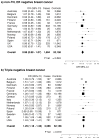19p13.1 is a triple-negative-specific breast cancer susceptibility locus
- PMID: 22331459
- PMCID: PMC3319792
- DOI: 10.1158/0008-5472.CAN-11-3364
19p13.1 is a triple-negative-specific breast cancer susceptibility locus
Abstract
The 19p13.1 breast cancer susceptibility locus is a modifier of breast cancer risk in BRCA1 mutation carriers and is also associated with the risk of ovarian cancer. Here, we investigated 19p13.1 variation and risk of breast cancer subtypes, defined by estrogen receptor (ER), progesterone receptor (PR), and human epidermal growth factor receptor-2 (HER2) status, using 48,869 breast cancer cases and 49,787 controls from the Breast Cancer Association Consortium (BCAC). Variants from 19p13.1 were not associated with breast cancer overall or with ER-positive breast cancer but were significantly associated with ER-negative breast cancer risk [rs8170 OR, 1.10; 95% confidence interval (CI), 1.05-1.15; P = 3.49 × 10(-5)] and triple-negative (ER-, PR-, and HER2-negative) breast cancer (rs8170: OR, 1.22; 95% CI, 1.13-1.31; P = 2.22 × 10(-7)). However, rs8170 was no longer associated with ER-negative breast cancer risk when triple-negative cases were excluded (OR, 0.98; 95% CI, 0.89-1.07; P = 0.62). In addition, a combined analysis of triple-negative cases from BCAC and the Triple Negative Breast Cancer Consortium (TNBCC; N = 3,566) identified a genome-wide significant association between rs8170 and triple-negative breast cancer risk (OR, 1.25; 95% CI, 1.18-1.33; P = 3.31 × 10(-13)]. Thus, 19p13.1 is the first triple-negative-specific breast cancer risk locus and the first locus specific to a histologic subtype defined by ER, PR, and HER2 to be identified. These findings provide convincing evidence that genetic susceptibility to breast cancer varies by tumor subtype and that triple-negative tumors and other subtypes likely arise through distinct etiologic pathways.
©2012 AACR.
Figures

References
-
- Stacey SN, Manolescu A, Sulem P, Rafnar T, Gudmundsson J, Gudjonsson SA, et al. Common variants on chromosomes 2q35 and 16q12 confer susceptibility to estrogen receptor-positive breast cancer. Nat Genet. 2007;39:865–9. - PubMed
-
- Stacey SN, Manolescu A, Sulem P, Thorlacius S, Gudjonsson SA, Jonsson GF, et al. Common variants on chromosome 5p12 confer susceptibility to estrogen receptor-positive breast cancer. Nat Genet. 2008;40:703–6. - PubMed
Publication types
MeSH terms
Substances
Grants and funding
- U01 CA069417/CA/NCI NIH HHS/United States
- R25 CA092049/CA/NCI NIH HHS/United States
- K07 CA092044/CA/NCI NIH HHS/United States
- C490/A10124/CRUK_/Cancer Research UK/United Kingdom
- 090532/WT_/Wellcome Trust/United Kingdom
- U01 CA69631/CA/NCI NIH HHS/United States
- 10118/CRUK_/Cancer Research UK/United Kingdom
- U01 CA069638/CA/NCI NIH HHS/United States
- CA116201/CA/NCI NIH HHS/United States
- P30 CA016056/CA/NCI NIH HHS/United States
- U01 CA69417/CA/NCI NIH HHS/United States
- U01 CA069467/CA/NCI NIH HHS/United States
- RFA-CA-06-503/CA/NCI NIH HHS/United States
- P30 CA016056-32/CA/NCI NIH HHS/United States
- 11022/CRUK_/Cancer Research UK/United Kingdom
- R01 CA058860/CA/NCI NIH HHS/United States
- CA122340/CA/NCI NIH HHS/United States
- 5U01 CA113916/CA/NCI NIH HHS/United States
- C8197/A10123/CRUK_/Cancer Research UK/United Kingdom
- BREAST CANCER NOW RESEARCH CENTRE/BBC_/Breast Cancer Now/United Kingdom
- CA92044/CA/NCI NIH HHS/United States
- P50 CA116201/CA/NCI NIH HHS/United States
- U01 CA113916/CA/NCI NIH HHS/United States
- CA58860/CA/NCI NIH HHS/United States
- C1287/A12014/CRUK_/Cancer Research UK/United Kingdom
- U01 CA069631/CA/NCI NIH HHS/United States
- R01 CA077398/CA/NCI NIH HHS/United States
- U01 CA69638/CA/NCI NIH HHS/United States
- ImNIH/Intramural NIH HHS/United States
- R01 CA77398/CA/NCI NIH HHS/United States
- U01 CA058860/CA/NCI NIH HHS/United States
- C8197/A10865/CRUK_/Cancer Research UK/United Kingdom
- R01 CA122340/CA/NCI NIH HHS/United States
- C1287/A10118/CRUK_/Cancer Research UK/United Kingdom
- U01 CA69467/CA/NCI NIH HHS/United States
- 10124/CRUK_/Cancer Research UK/United Kingdom
- 2004NOV49/BBC_/Breast Cancer Now/United Kingdom
LinkOut - more resources
Full Text Sources
Medical
Molecular Biology Databases
Research Materials
Miscellaneous

